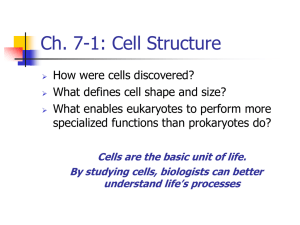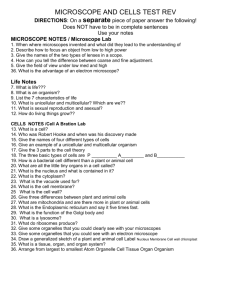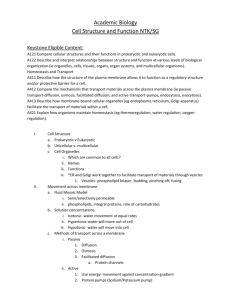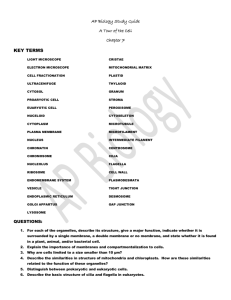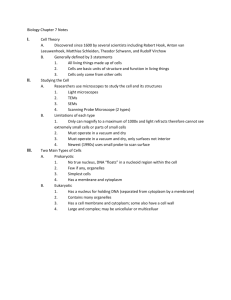Ch. 4 CELL STRUCTURE AND FUNCTION
advertisement
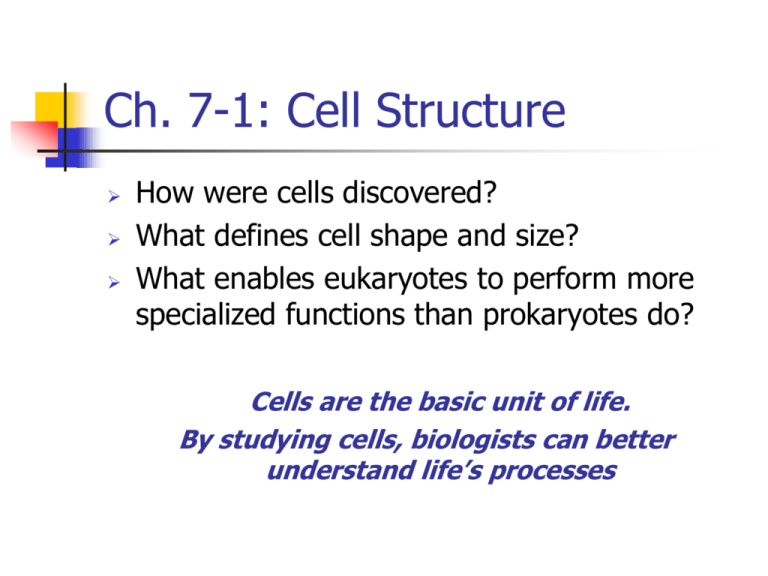
Ch. 7-1: Cell Structure How were cells discovered? What defines cell shape and size? What enables eukaryotes to perform more specialized functions than prokaryotes do? Cells are the basic unit of life. By studying cells, biologists can better understand life’s processes Cells and their discovery Cells are the smallest units of matter that can be living Characteristics of living include: take in energy, highly organized, reproduce, homeostasis, adapt, respond, grow and made of cells Cells are composed of C,H,N,O,P,S; often arranged into macromolecules Proteins, carbohydrates, lipids and nucleic acids Persons involved in discovery Anton von Leeuwenhoek : microscope Robert Hooke : term ‘cell’ Robert Brown : nucleus M. Schleiden : all plants have cells T. Schwann : all animals have cells R. Virchow : cells from other cells Diversity of cells Human body has at least 200 types of cells (within our trillions of cells) Size Shape Squamous, cuboidal, spherical Internal Organization Can be meters long, but only mm thick Surface area to volume ratio limits size, inefficient if either too large or too small Organelles = ‘little organ’ or ‘organ –like’ “Cell Specialization” Microscope Types Compound Light Microscope (CLM) Stereo scope or Dissecting scope Light through, stain, 2000x 3-D Electron Microscope Scanning Electron Microscope (SEM) Transmission Electron Microscope (TEM) Prokaryotes vs. Eukaryotes Cell membrane Cytoplasm Genetic material And ribosomes Bacteria only Small Many have cell wall that is either carb (Gram+) or lipid (Gram-) May have cilia or flagella Only 1 circular chromosome (+ maybe some plasmids) No membrane-bound organelles Cell membrane Cytoplasm Genetic material And ribosomes Plants, animals, protista and fungi Plants have CW= cellulose and fungi have CW = chitin, some protista have walls Variety of organelles and structures Many chromosomes in a NUCLEUS Lots of membrane bound organelles Cell Theory Cells are the basic structural and functional units of all living organisms All parts of all plants are made of cells All parts of all animals are made of cells All cells come from pre-existing cells “Working document” with new discoveries added as the technology becomes available. For instance viruses are not cells and we are trying to create cells. Accumulation of information since 1600’s through electron microscopes Cell Membrane Refers to all membranes Selectively permeable Two rows of lipid tails that face each other with phosphate head that are on the surfaces Fluid mosaic Certain substances are allowed to enter freely, some are carried across, some are rejected Phospholipid bilayer everywhere cells have them in all cells. Proteins that are within membrane can migrate Integral proteins Peripheral proteins LOTS more on this in Chpt. 8 Cytoplasm (aka protoplasm) Everything inside the cell membrane Just the liquid is called cytosol Cyto = cell Mostly water Dissolved proteins, enzymes, amino acids, carbohydrates, salts, minerals, organic compounds…… Site of all chemical reactions ‘parts’ within the cell are organelles 7-2 Organelles What does the cytoskeleton do? How does DNA direct activity in the cytoplasm? What organelles participate in protein production? What is the role of vesicles in the cell? How do cells get energy? Knowing how cells work helps you understand how your body functions and what goes wrong when you get sick. Organelles – USE your chart (Chart will be a handout and on website) Mitochondrion Ribosome ; free and attached Endoplasmic reticulum ; smooth and rough Golgi apparatus/body Lysosome and peroxisomes Cytoskeleton ; microtubules and microfilaments Cilia and flagella Nucleus – nuclear membrane, chromosomes and centrioles Cell wall Vacuoles – food, water, pigment Plastids - Chloroplast, chromoplast and leukoplast Water vacuole in plants sometimes called tonoplast Sample PROTISTA 7-3: From Cell to Organism What makes cells and organisms different? How are cells organized in a complex, multicellular organism? What makes an organism truly multicellular? Diverse cells have unique cells and cellular organization. Organization Unicellular – organisms like bacteria and algae that are complete, but only one cell Colonial organisms – function as a group with some division of labor, but no specialized tissues. Ex. volvox Multicellular – organisms composed of many (thousands to billions) of cells that are organized around collections of specialized tissues Multicellular Organization Similar cells = tissue Tissues doing a similar job = organ Plants have reproductive, vegetative and ground tissue Organs then collect into organ systems to make the organism Integumentary, skeletal, muscular, nervous (CNS, PNS), digestive, circulatory, respiratory, reproductive, excretory and endocrine. Also immune system and lymphatic system. Critical thinking questions: leave space for answers These HW questions are due on ___________ 1. Mature RBC’s have no nucleus or mitochondria. They are mostly membrane with hemoglobin. What is the advantage? __________ 2. Coils of a radiator provide a huge surface area where heat is radiated into a room – which organelle is similar? How is structure related to function? ______________________________________ 3. What characteristic of eukaryotic cells gives them greater capacity for specialization than prokaryotic cells? ______________________ 4. Livestock in the western US die after eating locoweed (Astragalus toanus). The chemical in the plant is poisonous. How does the plant keep from poisoning itself? _________________________________ 5. Explain the relationship between surface area and volume. ______ Group Assignment: describing and visualizing the cells found in a variety of kingdoms. Due on : ________________ Make a presentation (power point) using GOOGLE Must have 7 slides Slides 2-6 must have a description of a kingdom (Eubacteria, Protista, Fungi, Plantae and Animalia) AND at least 4 images that show a representative visual description of the kingdom. (Plants can’t be 4 trees) Slide 4 needs 4 images PLUS pictures of root, stem and leaf CELLS Slide 5 needs 4 images PLUS pictures of at least 3 specific cells ( things like muscle and bone or blood) Slide 1 is everyone’s name Slide 7 is your works cited page with references and credit for images used Email finished presentation to brhodes@gl.k12.mi.us
